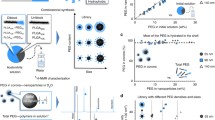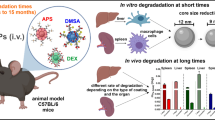Abstract
Purpose. In a biomimetic approach to the development of drug carriers escaping early capture by phagocytes, nanoparticles made of amphiphilic copolymers of either heparin or dextran and methyl methacrylate were evaluated relative to their in vivo blood circulation time. They were compared to bare PMMA nanoparticles.
Methods. Owing to the fluorescent properties of the covalently attached N-vinyl carbazole, the particles could be detected directly in mouse plasma. Samples were drawn at different time intervals and fluorescence was recorded.
Results. After an initial phase of elimination from the blood with a half-life of 5 h, the remaining heparin nanoparticles circulated for more than 48 h and were still detectable in the plasma at 72 h. Dextran nanoparticles were also eliminated very slowly over 48 h. Bare poly (methyl methacrylate) nanoparticles were found to have a half-life of only 3 min.
Conclusions. Both types of nanoparticles proved to be long-circulating. The potent capacity for opsonisation of the poly(methyl methacrylate) core were hidden by the protective effect of either polysaccharide, probably due to a dense brush-like structure. In the case of heparin nanoparticles, the 'stealth' effect was probably increased by its inhibiting properties against complement activation.
Similar content being viewed by others
REFERENCES
F. Puisieux, G. Barratt, G. Couarraze, P. Couvreur, J. P. Devissaguet, C. Dubernet, E. Fattal, H. Fessi, C. Vauthier, and S. Benita. Polymeric micro-and nanoparticles as drug carriers. In S. Dumitriu (Ed), Polymeric Biomaterials, Marcel Dekker, Inc., New York, 1994, pp. 749–794.
S. I. Jeon, J. H. Lee, J. D. Andrade, and P. G. de Gennes. Proteinsurface interactions in the presence of polyethylene oxide: simplified theory. J. Colloid Interf. Sci. 142:149–166 (1991).
M. C. Woodle and D. D. Lasic. Sterically stabilized liposomes. Biochim. Biophys. Acta 113:171–199 (1992).
R. Gref, Y. Minamitake, M. T. Peracchia, V. Trubetskoy, V. Torchilin, and R. Langer. Biodegradable long-circulating polymeric nanospheres. Science 263:1600–1603 (1994).
M. Vittaz, D. Bazile, G. Spenlehauer, T. Verrecchia, M. Veillard, F. Puisieux, and D. Labarre. Effect of PEO surface density on long-circulating PLA-PEO nanoparticles which are very low compliment activations. Biomaterials 17:1575–1581 (1996).
H. Sahli, J. Tapon-Bretaudière, A. M. Fischer, C. Sternberg, G. Spenlehauer, T. Verrecchia, and D. Labarre. Interactions of poly (lactic acid) and poly(lactic acid-co-ethylene oxide) nanoparticles with the plasma factors of the coagulation system. Biomaterials 18:281–288 (1997).
M. T. Peracchia, C. Vauthier, C. Passirani, P. Couvreur, and D. Labarre. Complement consumption by poly(ethylene glycol) in different conformations chemically coupled to poly(isobutyl 2-cyanoacrylate) nanoparticles. Life Sci. 61:749–761 (1997).
S. D. Tröster, U. Müller, and J. Kreuter. Modification of the body distribution of poly(methyl methacrylate) nanoparticles in rats by coating with surfactants. Int. J. Pharm. 61:85–100 (1990).
T. Blunk, D. F. Hochstrasser, J. C. Sanchez, B. W. Müller, and R. H. Müller. Colloidal carriers for intravenous drug targeting: plasma protein adsorption patterns on surface-modified latex particles evaluated by two-dimensional polyacrylamide gel electrophoresis. Gel Electrophoresis 14:1382–1387 (1993).
T. M. Allen and A. Chonn. Large unilamellar liposomes with low uptake into the reticulo-endothelial system FEBS Lett. 223:42–46 (1987).
F. Maillet, M. D. Kazatchkine, D. Glotz, E. Fischer, and M. Rowe. Heparin prevents formation of the human C3 amplification convertase by inhibiting the binding site for B on C3b. Molec. Immun. 20:1401–1404 (1983).
H. P. Ekre, Y. Naparstek, O. Lider, P. Hydén, Ö. Hägermark, T. Nilsson, I. Vlodavsky, and I. Cohen. Anti-inflammatory effects of heparin and its derivatives inhibition of complement and of lymphocyte migration. In D. A. Lane (Ed.), Heparin and Related Polysaccharides, Plenum Press, New York, 1992, pp. 329–340.
J. Weiler and R. Linhardt. Comparison of the activity of polyanions and polycations on the classical and alternative pathways of complement. Immunopharmacology 17:65–72 (1989).
M. D. Kazatchkine, D. Fearon, J. Silbert, and K. Austen. Surface-associated heparin inhibits zymosan-induced activation of the human alternative pathway by augmenting the regulatory action of the control proteins on particle-bound C3b. J. Exp. Med. 150:1202–1215 (1979).
D. J. Labarre. Heparin-like polymer surfaces: control of coagulation and complement activation by insoluble functionalized polymers. Int. J. Artif. Organs 13:651–657 (1990).
R. Larsson, G. Selén, H. Björklund, and P. Fagerholm. Intraocular PMMA lenses modified with surface-immobilized heparin: evaluation of biocompatibility in vitro and in vivo. Biomaterials 10:511–516 (1989).
M. Pekna, R. Larsson, B. Formgren, U. R. Nilsson, and B. Nilsson. Complement activation by polymethylmethacrylate minimized by end-point heparin attachment. Biomaterials 14:189–192 (1993).
J. Riesenfeld, P. Olsson, J. Sanchez, and E. Mollnes. Surface modification with functionally active heparin. Med. Dev. Tech. 24–31 (1995).
W. Marconi, F. Benvenuti, and A. Piozzi. Covalent bonding of heparin to a vinyl copolymer for biomedical applications. Biomaterials 18:885–890 (1997).
M. P. Carreno, D. Labarre, M. Jozefowicz, and M. D. Kazatchkine. The ability of sephadex to activate human complement is suppressed in specifically substituted functional sephadex derivatives. Mol. Immunol. 25:165–171 (1988).
M. P. Carreno, F. Maillet, D. Labarre, M. Jozefowicz, and M. D. Kazatchkine. Specific antibodies enhance sephadex-induced activation of the alternative complement pathway in human serum. Biomaterials 9:514–518 (1988).
F. Maillet and M. D. Kazatchkine. Specific antibodies enhance alternative complement pathway activation by cuprophane. Nephrol. Dial. Transplant. 6:193–197 (1991).
C. Passirani, G. Barratt, J. P. Devissaguet, and D. Labarre. Interaction of nanoparticles bearing heparin or dextran covalently bound to poly(methyl methacrylate) with the complement system. Life Sci. 62:775–785 (1998).
A. North and K. Whitelock. The free radical copolymerization of N-vinyl carbazole. Polymer 9:590–591 (1968).
J. Bevington, C. Dyball, and J. Leech. Polymerization of N-vinyl-carbazole: studies of copolymerizations with methyl methacrylate and styrene. Makromol. Chem. 180:657–661 (1979).
J. Kreuter. Nanoparticles. In J. Kreuter (ed.), Colloidal Drug Delivery Systems, Marcel Dekker, Inc., New York, 1994, pp. 219–342.
P. Couvreur, L. Grislain, V. Lenaerts, F. Brasseur, P. Guiot, and A. Biornacki. Biodegradable polymeric nanoparticles as drug carrier for antitumor agents. In P. Guiot and P. Couvreur (eds.), Polymeric Nanoparticles and Microspheres, CRC Press, Boca Raton, Florida, 1986, pp. 27–93.
L. Illum, S. S. Davis, C. G. Wilson, N. W. Thomas, M. Firer, and J. G. Hardy. Blood clearance and organ deposition or intravenously administered colloidal particles; the effect of particle size, nature and shape. Int. J. Pharm. 12:135–146 (1982).
T. Verracchia, G. Spenlehauer, D. V. Bazile, A. Murry-Brelier, Y. Archimbaud, and M. Veillard. Non-stealth (poly(lactic acid / albumin)) and stealth (poly (lactic acid-polyethylene glycol)) nanoparticles as injectable drug carriers. J. Control. Rel. 36:49–61 (1995).
W. A. Patton, C. A. Granzow, L. A. Getts, S. C. Thomas, L. M. Zotter, K. A. Gunzel, and L. J. Lowe-Krentz. Identification of a heparin-binding protein using monoclonal antibodies that block heparin binding to porcin aortic endothelial cells. Biochem. J. 311:461–469 (1995).
Author information
Authors and Affiliations
Rights and permissions
About this article
Cite this article
Passirani, C., Barratt, G., Devissaguet, JP. et al. Long-Circulating Nanopartides Bearing Heparin or Dextran Covalently Bound to Poly(Methyl Methacrylate). Pharm Res 15, 1046–1050 (1998). https://doi.org/10.1023/A:1011930127562
Issue Date:
DOI: https://doi.org/10.1023/A:1011930127562




